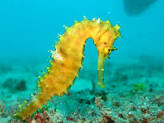
……as Becky Lofts, of the Seahorse Trust told Coastwise members. She is an experienced diver and found these little fish, of sizes from 2.5cm up to 32cm, very difficult to spot underwater, which may have contributed to their reputation for rarity.
The Trust was founded in 1999, when it was discovered that sea horses are indigenous, and the need for research and conservation was realised..
Hippocampus or Guttalatus species are found all round the British Isles, including Dogger Bank, the Scillies and the Channel Islands.
They do have gills which work as vents, with air intake through siphons on the top of the head. They can tolerate fresh water for a short time, and can see in very low light so are sensitive to, e.g. flash photography.
Sea horses can change colour for two reasons – to blend in to a background, and with changing emotions, like cuttlefish.
They appear to be almost unique in breeding habits, as the male accepts eggs through an ovipositor from a female, and then has true pregnancy, with the eggs growing to birth stage in the egg pouch, taking nutrients from the male. Up to 1500 young can be borne, with probably only a 1% survival rate.
Seahorses are a threatened species due to human predation; some people think that the dried bodies have magical medical properties, and large numbers are also sold as curios. However, the largest take from the wild is for the aquarium trade.
The Seahorse Trust is pursuing conservation by education, habitat protection, and experimenting with captive breeding, and fortunately there is plenty of legal protection in place.
Thanks to Becky for filling in at short notice, and giving a very informative talk.

